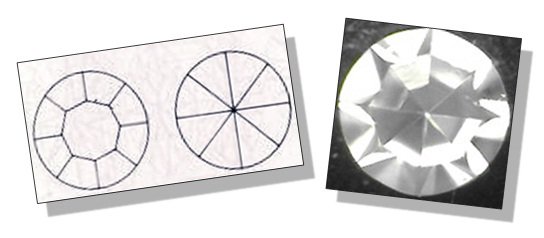Simplified Cut Diamond
It was since the middle of 14th century that diamond became popular in jewelry. And over the period of time, various cuts and techniques have come in the market.
Among all the diamond cuts, the round cut is the most classic cut. However, before moving further go through Parts of Round Brilliant Cut and Facets of Diamond, as this will help you understand the terminologies used on this page.
Diamond of small size is given fewer facets which is termed as Simplified Cut. This is because a full cut diamond (58 facets) of size less than 2 point (1 point = 1 cent = 0.01 carat) would appear milky to human eye due to its inability to disperse the incident light.
Simplified cut can be classified into:
- Single Cut
- Swiss Cut
Single Cut
The single cut is also called the Eight cut. Following are its facets’ specifications:
| No. of facets on Crown | 8 |
| No. of facets on Pavilion | 8 |
| No. of Table facets | 1 |
| No. of Culet facets | 1 |

This cut is generally used for very small diamonds of size below 1 or 2 points. The advantage of single cut is that, their fewer but larger facets sparkles more than full cut (58 facets) diamond of same size.
Swiss Cut
The Swiss cut is also called the sixteen cut. Following are its facets’ specifications:
| No. of facets on Crown | 16 |
| No. of facets on Pavilion | 8 |
| No. of Lower Girdle facets | 8 |
| No. of Table facets | 1 |
| No. of Culet facets | 1 |

So, it could be said that with 34 facets, Swiss cut lies between Single cut and Round Brilliant cut.
Return from Simplified Cut to Cuts of Diamond page
Return from Simplified Cut to Diamond Jewelry Homepage
I hope you'll not mind sharing this on Twitter, Facebook and with everyone else :)
Feel free to share if something is in your mind and want it to be covered on this site.
My Newsletter
Did you liked this article? Sign-up my FREE weekly newsletter and I'll send you more awesome new additions on this website along with latest jewelry happenings around the world, and download my Jewelry Design Album for FREE!
 |
|


